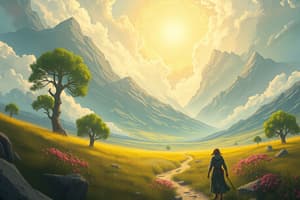Podcast
Questions and Answers
What are the two eras in which the Karoo landscape's roots are found?
What are the two eras in which the Karoo landscape's roots are found?
Paleozoic and Mesozoic Eras
What is the primary reason for the limited water availability in the Karoo landscape?
What is the primary reason for the limited water availability in the Karoo landscape?
Seasonal rainfall and scarce surface water
What type of rocks were deposited in the Karoo region during the Paleozoic and Mesozoic Eras?
What type of rocks were deposited in the Karoo region during the Paleozoic and Mesozoic Eras?
Sedimentary and volcanic rocks
What is the term for the dry riverbeds found in the Karoo landscape?
What is the term for the dry riverbeds found in the Karoo landscape?
What is the term for the flat-topped hills found in the Karoo landscape?
What is the term for the flat-topped hills found in the Karoo landscape?
What is the term for the pan-like depressions found in the Karoo landscape?
What is the term for the pan-like depressions found in the Karoo landscape?
What process led to the formation of the African continent?
What process led to the formation of the African continent?
What is the primary type of vegetation found in the Karoo landscape?
What is the primary type of vegetation found in the Karoo landscape?
What is the term for the rocky outcrops found in the Karoo landscape?
What is the term for the rocky outcrops found in the Karoo landscape?
What are the three main processes that have shaped the Karoo landscape over millions of years?
What are the three main processes that have shaped the Karoo landscape over millions of years?
Flashcards are hidden until you start studying
Study Notes
Formation and Characteristics
- The Karoo landscape is a type of semi-arid to arid landscape found in southern Africa, particularly in South Africa and Namibia.
- It is characterized by:
- Gently sloping to flat plains
- Scattered rocky outcrops
- Limited vegetation, mainly consisting of grasses, shrubs, and succulents
- Limited water availability, with seasonal rainfall and scarce surface water
Geological History
- The Karoo landscape has its roots in the Paleozoic and Mesozoic Eras, with the formation of the supercontinent Gondwana.
- The region experienced extensive volcanic activity, resulting in the deposition of thick layers of sedimentary and volcanic rocks.
- The breakup of Gondwana led to the formation of the African continent, and the Karoo landscape was shaped by erosion and deposition over millions of years.
Landforms and Features
- The Karoo landscape is dominated by:
- Flat-topped hills (kopjes)
- Rocky outcrops (koppies)
- Dry riverbeds (dongas)
- Pan-like depressions (vleis)
- The landscape has been shaped by a combination of tectonic uplift, erosion, and deposition.
Climatic Factors
- The Karoo landscape is influenced by:
- Low rainfall (less than 400 mm annually)
- High evaporation rates
- Seasonal rainfall patterns, with most rainfall occurring during the summer months
- Limited vegetation cover, leading to high rates of soil erosion
Ecological Importance
- The Karoo landscape supports a unique and diverse range of flora and fauna, adapted to the harsh environmental conditions.
- The region is home to a variety of endemic species, found nowhere else in the world.
- The Karoo landscape provides important ecosystem services, including:
- Carbon sequestration
- Soil conservation
- Water filtration
Formation and Characteristics
- Semiarid to arid landscape found in southern Africa, particularly in South Africa and Namibia
- Characterized by gently sloping to flat plains, scattered rocky outcrops, and limited vegetation
- Limited water availability, with seasonal rainfall and scarce surface water
- Vegetation mainly consists of grasses, shrubs, and succulents
Geological History
- Originated in the Paleozoic and Mesozoic Eras with the formation of the supercontinent Gondwana
- Region experienced extensive volcanic activity, resulting in thick layers of sedimentary and volcanic rocks
- Breakup of Gondwana led to the formation of the African continent, shaping the Karoo landscape through erosion and deposition
Landforms and Features
- Dominated by flat-topped hills (kopjes), rocky outcrops (koppies), dry riverbeds (dongas), and pan-like depressions (vleis)
- Landscape shaped by tectonic uplift, erosion, and deposition
Climatic Factors
- Influenced by low rainfall (less than 400 mm annually), high evaporation rates, and seasonal rainfall patterns
- Most rainfall occurs during the summer months
- Limited vegetation cover leads to high rates of soil erosion
Ecological Importance
- Supports a unique and diverse range of flora and fauna adapted to harsh environmental conditions
- Home to a variety of endemic species found nowhere else in the world
- Provides important ecosystem services, including carbon sequestration, soil conservation, and water filtration
Studying That Suits You
Use AI to generate personalized quizzes and flashcards to suit your learning preferences.



